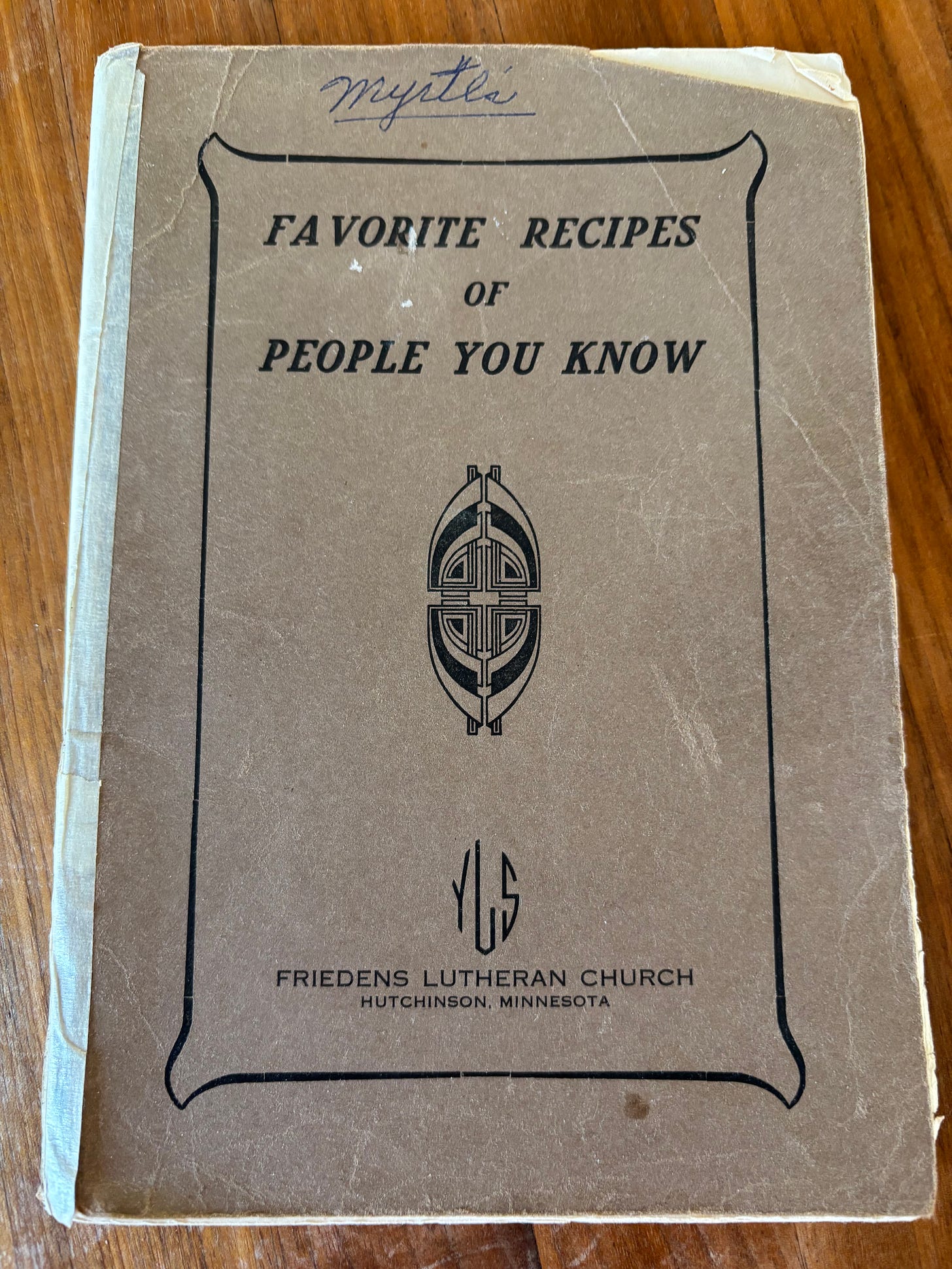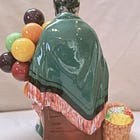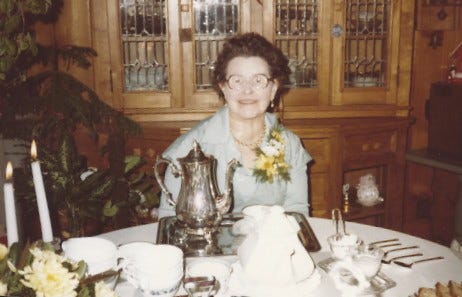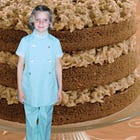May the relish be with you
A brief history of relish from when it was both practical and sophisticated
Release date: May 2, 2025
A vintage recipe book with family ties
The only kind of relish I remember seeing in our house when I was growing up was pickle relish, and the only time it came out of the fridge was in the summer when Dad fired up his black Weber grill to make hotdogs or hamburgers. Not being a fan of pickles, I ate my hotdogs sans relish, but slathered in ketchup.
I’m still not a fan of pickles, and only keep a jar of pickle relish in the fridge for my husband, who enjoys a little crunch in his tuna sandwiches. I take no responsibility for the use-by date on that jar, btw.
I mention relish because, awhile back, I came across a 1948 copy of Favorite Recipes of People You Know, put out by the ladies of Friedens Lutheran Church in Hutchinson, MN.
Friedens Lutheran, which later became Peace Lutheran, has been a part of our family history for 120 years, ever since my great-grandparents, Rudolph Semerau and Minnie Meinke, were married there on February 21, 1905. Most everyone in the Semerau family was either baptized, confirmed, married or buried at Friedens/Peace Lutheran, including me – at least the baptized part.
The recipe book I have in my collection was owned by my maternal grandpa’s sister, Myrtle Violet Semerau Mitchell. If you’ve been here awhile, you might remember Auntie Myrtle from previous stories, including these two.
I love community cookbooks, the older the better. They perfectly capture the time, place and women who contributed to them. Over the years, I’ve intentionally sought out community cookbooks in nearly all the small towns in which my ancestors lived, and I’m always amazed at how often I come across familiar names — and family recipes.
The Friedens recipe book is no different. It includes recipes submitted by Myrtle, but also my grandma, my godmother and a number of women whose names I recognize, either because I met them when I was younger or because I remember hearing my grandparents and parents talking about them.
In paging through Myrtle’s copy of Favorite Recipes of People You Know, I was surprised at the number of relish recipes I came across.
Corn Relish, Pepper Relish, Apple Relish, Beet Relish, Celery Relish, Pineapple Relish.
What’s up with that?
Waste not want not
Food history suggests relish as we know it today has been around for centuries, and likely came to the American colonies around the time of the Revolution, probably by way of merchant ships. The word itself, however, comes from the Old French reles, meaning "something remaining," which is fitting, as most relishes are made from left over or surplus fruits and vegetables.
It's not hard to imagine the appeal of a tangy, flavorful side dish to accompany the often bland and unremarkable foods of our ancestors. But, making relish had a practical side, as well. Before refrigeration, canning and pickling were essential for extending the shelf life of garden produce into the winter months, and helped to fend off both hunger and disease.
Of course, by the time the women of Friedens Lutheran Church put together their recipe book, nearly every home had a refrigerator, and most families bought their fruits and vegetables at the local grocery store. But the legacy of thriftiness was still strong, at least in my family. Born in 1907, Myrtle had lived through the food insecurity of two world wars and the Great Depression – to her, the vegetable garden behind the house wasn’t just a place to relax and unwind, it was a lifeline.
And wastefulness was out of the question.
In the same way that trimmings left behind after butchering a pig were ground into sausage, the bits and pieces left over after putting up jars of beets, apples, celery and more were turned into relish.
Post-war sophistication
Auntie Myrtle was 47, single, and working as a bookkeeper the year the Friedens recipe book came out. She was also a popular and accomplished hostess. Among the many things I inherited from her when she passed away in 1986 are two relish dishes: a simple oval-shaped silver-plated piece with four compartments, and a brilliant antique cut glass piece featuring dramatic swirls and zigzagged edges.
As a hostess in post-war middle America, Auntier Myrtle would have filled those relish dishes with all sorts of wonderful pre-dinner or cocktail party snacks, things like celery stuffed with cream cheese or pimento cheese, pickled carrot sticks, an assortment of black and green olives and, of course, some sort of relish just waiting to be spread on a cracker or piece of crusty bread.
She may also have served relish as an accompaniment to whatever meat she was serving at a dinner party or other formal event, adding a little flair and sophistication to the meal.
Cookbooks and newspapers of the day were packed with relish recipes and entertaining tips like this one:
Here is an emerald gem of a relish to make life more attractive – and simpler – for the holiday hostess. Sparkling line-flavored gelatin is the base for this delicious relish with a piquancy of flavor that, once tasted, is sure to make it a lasting favorite.
Triple Green Relish we call this; for limes, olives and sweet pickles play a variation on the theme of green that is truly delightful. 1
Yummy, right?
Today, most of us think of relish as a simple condiment for hotdogs and hamburgers, and a relish tray as a plate filled with sliced carrots, cucumbers and celery, maybe some olives. Nothing sophisticated.
Sophisticated is a charcuterie board or maybe even a butter board.
But, times change. A lot of people are into canning and food preservation again. Sustainability and food security are back in the American lexicon.
Maybe its time for relish to make a comeback, too!
Copyright 2025 Lori Olson White
Relish recipes from Favorite Recipes of People You Know
Triple Green Relish
Ingredients:
1 package lime-flavored gelatin
¼ teaspoon salt
1 cup hot water
1 cup cold water
3 tablespoons vinegar
¾ cup sliced stuffed green olives
½ cup sliced sweet pickles
Instructions":
Dissolve gelatin and salt in hot water. Add cold water and vinegar. Chill until slightly thickened. Fold in olives and pickles. Pour into molds. Chill until form. Unmold on crisp lettuce. Garnish with mayonnaise. Serve as relish with roast or other meat. Makes 6 molds. 1
Your turn and your culinary traditions
What’s a dish or condiment your grandparents always had on the table that you rarely see today?
Think about a recipe in your family that was once considered "fancy" or "special occasion" food. Who made it, and what made it feel elevated or impressive at the time?
Did your family have a relish tray or something similar during holidays or gatherings? What items were always included, and what memories are tied to it?
Recall a time when food was used to impress guests in your family—what dishes were served, and how were they presented? How did these choices reflect your family’s values or aspirations?
Have you ever uncovered a handwritten recipe from an older relative? What clues does it give you about the time period, ingredients available, or that person’s personality?
What foods in your family history were considered “modern” or “convenient” at one time? How do those foods reflect the culture or technology of the era?
Is there a dish or recipe that was once popular in your family but slowly faded away? Why do you think it was lost—and what might it mean to bring it back?
In case you missed it
If stories at the intersection of food and family history are what you’re looking for, look no further than our archives! Here are a few of our favorites.
Please hit the “like” button if you enjoyed this newsletter — it’s a little thing you can do to support my work!
Culinary History is Family History is reader-supported. When you buy through links on our site, we may earn an affiliate commission.
End Notes:
1 “Sparkling Gelatin salad is a rhapsody in Green”, The Duluth News, Duluth, MN, February 1, 1956, P. 9.
















Oh jello recipes ! I have some stories of those coming up lol.
As to relish, there was another relish I grew up with, but I never considered it a relish. Each Thanksgiving we had two kinds of cranberries on the table - the jelled stuff right out the can and then a concoction of cranberrries and oranges which, it turns out, is technically a relish!
Thanks for sharing your memories, Ruth! How’s the road trip going?
What an entertaining piece, Lori! No one made relishes in my family that I know of, but there were many recipes passed down that reflected the dishes, convenience foods and entertainment norms of the ‘50s, ‘60s and ‘70s that influenced my mother and her friends—jello molds (with cottage cheese!), casseroles made with canned soups, elaborate dips and the same waste-not, want-not philosophy you describe.
I’m not a huge fan of relishes except for pickle relish on hotdogs or in tuna salad. I do love mustard and pickles, but most relishes are too sweet for my taste. However, sour pickles, sauerkraut and kimchee do hit the spot. I also like to try to recreate some of the old recipes but update—maybe less sugar and salt, more fresh ingredients.